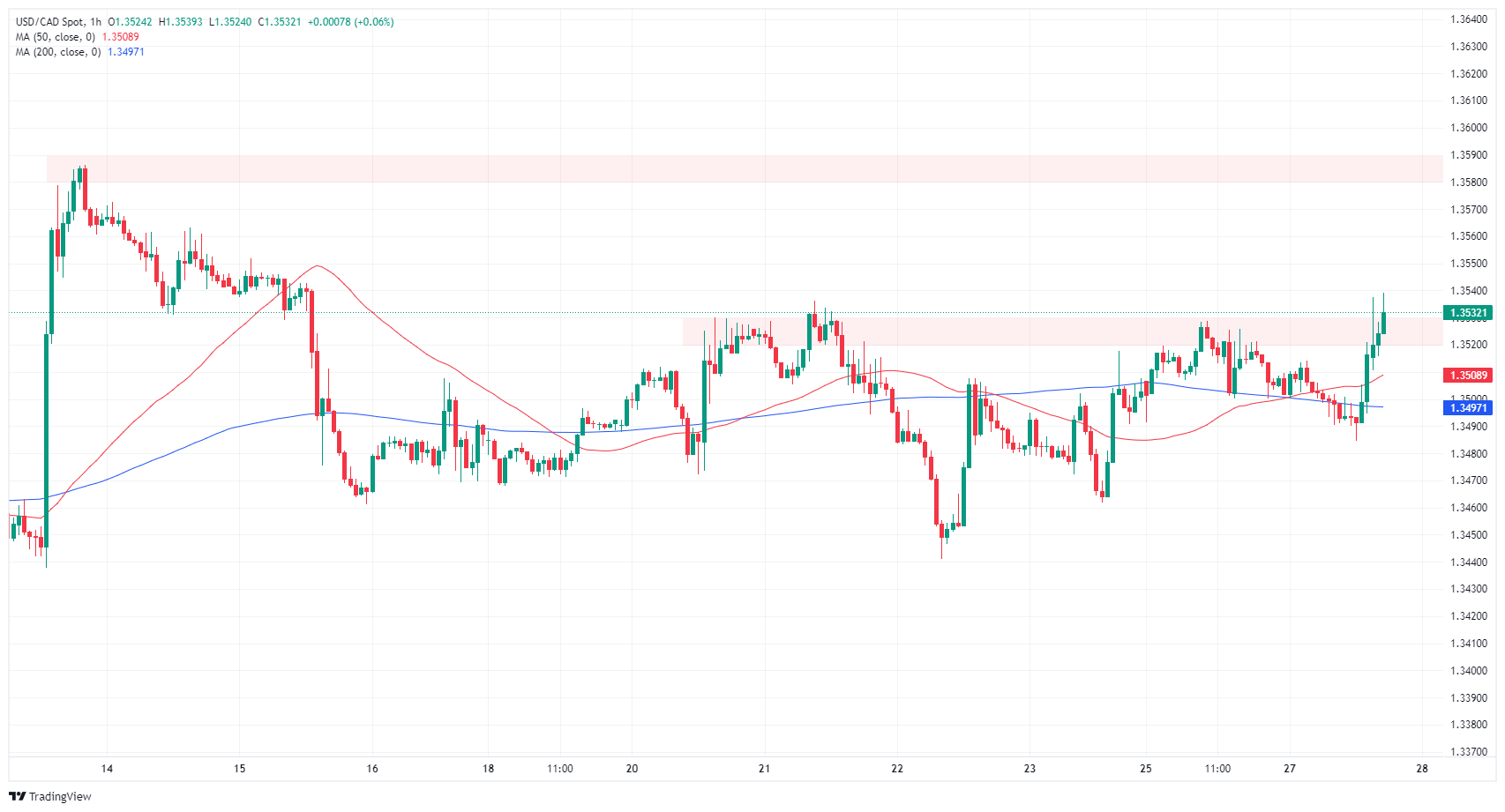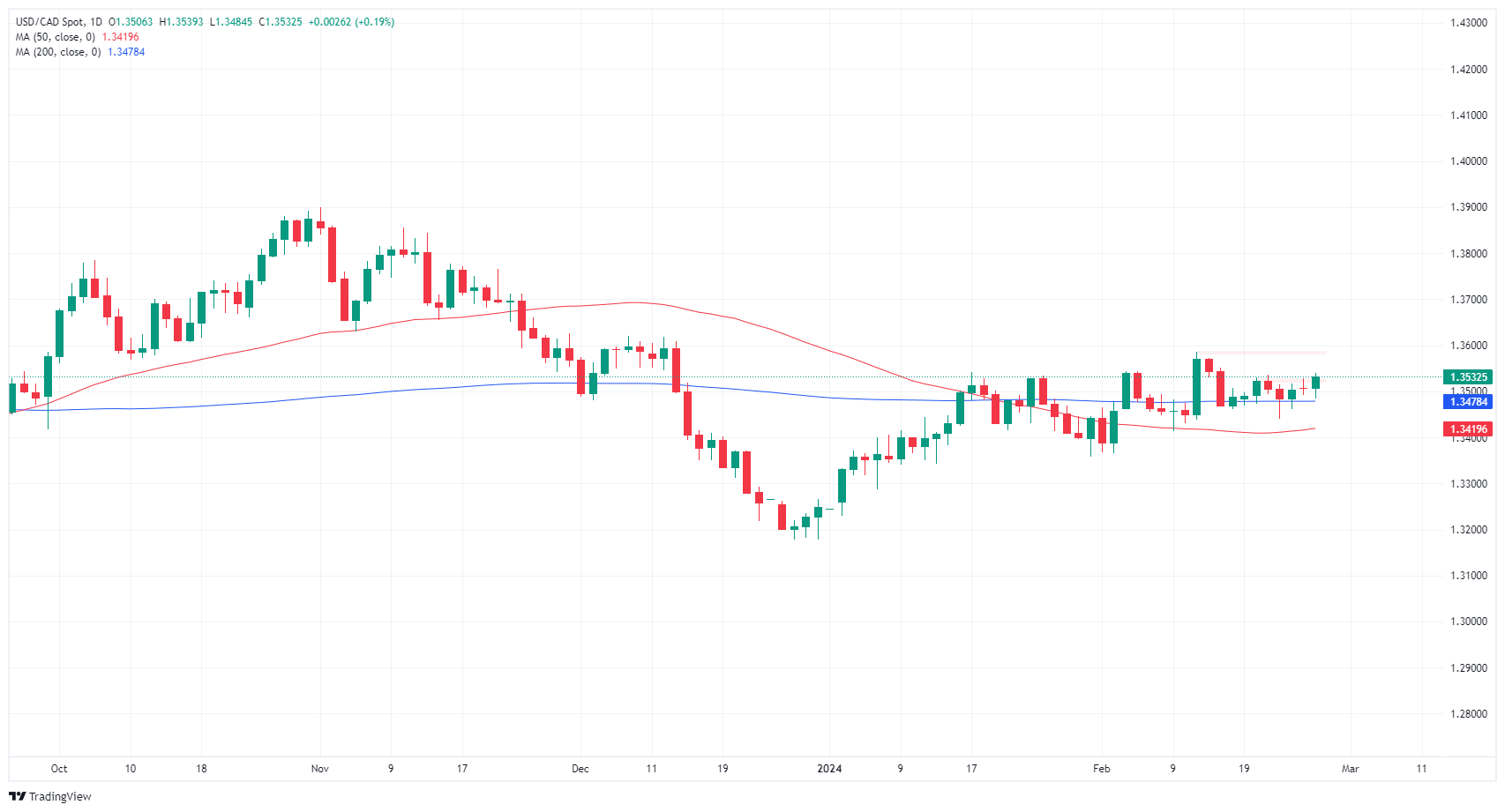USD/CAD climbs into fresh highs after US Durable Goods Orders flub forecasts

- USD/CAD started the day soft before a pivot in the US session.
- Canada absent from the economic calendar on Tuesday.
- US Durable Goods declined more than expected, US PCE in the pipe.
USD/CAD settled to an intraday low of 1.3484 before rallying back above the 1.3500 handle after US Durable Goods Orders declined more than expected. The pair remains mired in near-term congestion as markets await US Personal Consumption Expenditure Price Index (PCE) data on inflation later in the week.
Canada waits until Wednesday to make an appearance on the economic calendar with Q4’s Current Account. This Canadian data release will be overshadowed, however, by the US Gross Domestic Product (GDP) report due simultaneously at 13:30 GMT on Wednesday.
Daily digest market movers: USD/CAD pivots on Durable Goods miss
- US Durable Goods Orders declined 6.1% in January, missing the -4.5% forecast versus the previous month’s -0.3% (revised lower from 0.0%).
- The Conference Board Consumer Confidence Index also declined more than expected, printing at 106.7 versus the forecast of 115.0, previously 114.8.
- The US Housing Price Index rose less than expected in December, climbing just 0.1% MoM versus the 0.3% forecast. It was previously revised to 0.4% in November.
- Canada’s Q4 Current Account on Wednesday is expected to recover but still remain in negative territory, forecast to print at -1.25 billion versus -3.22 billion previously.
- US annualized Q4 GDP is forecast to hold steady at 3.3%.
- Canada’s Q4 GDP to follow on Thursday, markets expect a rebound in the yearly figure to 0.8% from -1.1%.
Canadian Dollar price today
The table below shows the percentage change of Canadian Dollar (CAD) against listed major currencies today. Canadian Dollar was the strongest against the US Dollar.
| USD | EUR | GBP | CAD | AUD | JPY | NZD | CHF | |
| USD | -0.02% | 0.00% | 0.21% | -0.03% | -0.04% | -0.03% | -0.04% | |
| EUR | 0.02% | 0.01% | 0.22% | -0.01% | -0.01% | -0.04% | -0.03% | |
| GBP | 0.01% | -0.01% | 0.21% | -0.03% | -0.03% | -0.06% | -0.05% | |
| CAD | -0.20% | -0.24% | -0.22% | -0.26% | -0.25% | -0.24% | -0.28% | |
| AUD | 0.04% | 0.01% | 0.03% | 0.24% | 0.00% | -0.02% | -0.01% | |
| JPY | 0.04% | 0.00% | 0.04% | 0.24% | 0.03% | 0.00% | 0.00% | |
| NZD | 0.02% | 0.03% | 0.02% | 0.25% | 0.01% | 0.00% | 0.03% | |
| CHF | 0.05% | 0.03% | 0.04% | 0.26% | 0.02% | 0.02% | 0.01% |
The heat map shows percentage changes of major currencies against each other. The base currency is picked from the left column, while the quote currency is picked from the top row. For example, if you pick the Euro from the left column and move along the horizontal line to the Japanese Yen, the percentage change displayed in the box will represent EUR (base)/JPY (quote).
Technical analysis: USD/CAD reclaims ground north of 1.3500
USD/CAD dipped into 1.3484 on Tuesday before recovering into the familiar 1.3530 level. The pair continues to churn around the 1.3500 handle, and the 200-hour Simple Moving Average (SMA) remains a key barrier to momentum in either direction in the near term.
The immediate technical barrier of February’s high of 1.3586 remains a key level for bulls to break through to challenge the 1.3600 handle. A rising pattern of higher lows on the daily candles provides technical support for immediate bullish momentum, but price action is trading into a heavy supply zone from 1.3500 to 1.3550.
USD/CAD hourly chart
USD/CAD daily chart
Canadian Dollar FAQs
The key factors driving the Canadian Dollar (CAD) are the level of interest rates set by the Bank of Canada (BoC), the price of Oil, Canada’s largest export, the health of its economy, inflation and the Trade Balance, which is the difference between the value of Canada’s exports versus its imports. Other factors include market sentiment – whether investors are taking on more risky assets (risk-on) or seeking safe-havens (risk-off) – with risk-on being CAD-positive. As its largest trading partner, the health of the US economy is also a key factor influencing the Canadian Dollar.
The Bank of Canada (BoC) has a significant influence on the Canadian Dollar by setting the level of interest rates that banks can lend to one another. This influences the level of interest rates for everyone. The main goal of the BoC is to maintain inflation at 1-3% by adjusting interest rates up or down. Relatively higher interest rates tend to be positive for the CAD. The Bank of Canada can also use quantitative easing and tightening to influence credit conditions, with the former CAD-negative and the latter CAD-positive.
The price of Oil is a key factor impacting the value of the Canadian Dollar. Petroleum is Canada’s biggest export, so Oil price tends to have an immediate impact on the CAD value. Generally, if Oil price rises CAD also goes up, as aggregate demand for the currency increases. The opposite is the case if the price of Oil falls. Higher Oil prices also tend to result in a greater likelihood of a positive Trade Balance, which is also supportive of the CAD.
While inflation had always traditionally been thought of as a negative factor for a currency since it lowers the value of money, the opposite has actually been the case in modern times with the relaxation of cross-border capital controls. Higher inflation tends to lead central banks to put up interest rates which attracts more capital inflows from global investors seeking a lucrative place to keep their money. This increases demand for the local currency, which in Canada’s case is the Canadian Dollar.
Macroeconomic data releases gauge the health of the economy and can have an impact on the Canadian Dollar. Indicators such as GDP, Manufacturing and Services PMIs, employment, and consumer sentiment surveys can all influence the direction of the CAD. A strong economy is good for the Canadian Dollar. Not only does it attract more foreign investment but it may encourage the Bank of Canada to put up interest rates, leading to a stronger currency. If economic data is weak, however, the CAD is likely to fall.
